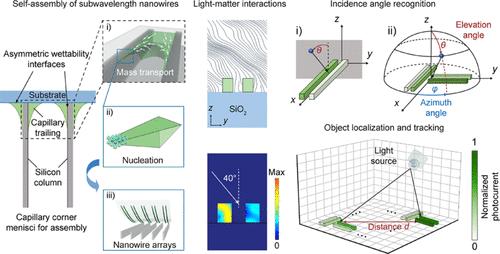Self-Assembled Subwavelength Nanophotonic Structures for Spatial Object Localization and Tracking
IF 14.4
1区 化学
Q1 CHEMISTRY, MULTIDISCIPLINARY
引用次数: 0
Abstract
Subwavelength resonant nanostructures have facilitated strong light–matter interactions and tunable degrees of freedom of light, such as spectrum, polarization, and direction, thus boosting photonic applications toward light emission, manipulation, and detection. For photodetection, resonant nanostructures have enabled emerging technologies, such as light detection and ranging, spectrometers, and polarimeters, within an ultracompact footprint. However, resonant nanophotonics usually relies on nanofabrication technology, which suffers from the trade-offs between precision and scalability. Here, we first realize the self-assembly of subwavelength resonant nanostructures of metal-halide perovskites for spatial object localization and tracking. By steering crystallization along capillary corner bridges localized at edges, we achieve single crystallinity, subwavelength size, and resonant coupling between perovskite nanowires, thus leading to an angle-resolved photodetector with an angular resolution of 0.523°. Furthermore, we integrate multiple pairs of coupled resonant nanowires along two orthogonal orientations to form angle-resolved photodetector arrays for spatial light localization of both static and moving objects with an error of less than 0.6 cm. These findings create a platform for self-assembled resonant nanostructures, thus paving the way for multifunctional nanophotonic and optoelectronic devices.

求助全文
约1分钟内获得全文
求助全文
来源期刊
CiteScore
24.40
自引率
6.00%
发文量
2398
审稿时长
1.6 months
期刊介绍:
The flagship journal of the American Chemical Society, known as the Journal of the American Chemical Society (JACS), has been a prestigious publication since its establishment in 1879. It holds a preeminent position in the field of chemistry and related interdisciplinary sciences. JACS is committed to disseminating cutting-edge research papers, covering a wide range of topics, and encompasses approximately 19,000 pages of Articles, Communications, and Perspectives annually. With a weekly publication frequency, JACS plays a vital role in advancing the field of chemistry by providing essential research.

 求助内容:
求助内容: 应助结果提醒方式:
应助结果提醒方式:


